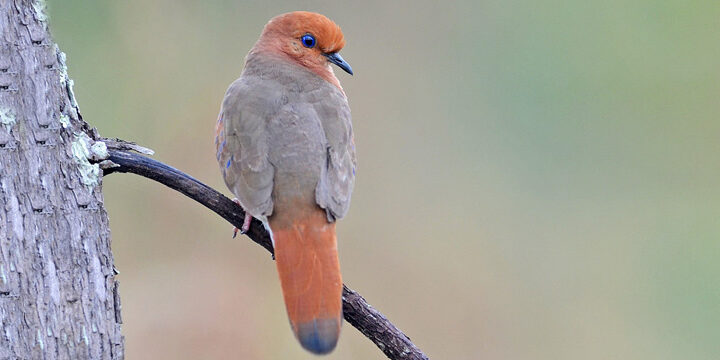Bird of The Week: Thick-billed Longspur
Scientific Name: Columbina cyanopis
Population: Estimated at 16 individuals
IUCN Status: Critically Endangered
Trend: Decreasing
Habitat: Tropical savanna of eastern Brazil
About the Blue-eyed Ground Dove
With a population estimated at just 16 birds, the Blue-eyed Ground-Dove is one of the rarest birds in a country that’s home to many rare species found nowhere else, including the Stresemann’s Bristlefront, Gray-breasted Parakeet, Marsh Antwren, and Cherry-throated Tanager.
This small, mostly cinnamon-colored dove is named for its vivid blue eyes, which match the spots dotting its wings. It was considered a lost species until its rediscovery in 2015, when ornithologist Rafael Bessa heard an unfamiliar bird while conducting field work.
Re-finding the Rarest
While conducting bird survey work in Brazil’s Minas Gerais state, Rafael Bessa heard an unfamiliar high-pitched, repeating call: “qwuk qwuk qwuk qwuk….” Immediately, he suspected something exciting. Bessa recorded the call and played it back. A Blue-eyed Ground-Dove appeared, making history. This was the first sighting in 75 years, and well to the east of the species’ known range in eastern Brazil’s vast tropical savanna, called the Cerrado.
Songs and Sounds
The Blue-eyed Ground-Dove has a soft, repetitive, rather high-pitched call. It has been known to sing throughout the day, often perched alone in a low-lying bush.
Breeding and Feeding
Playing Catch-Up
Scientists continue to study the Blue-eyed Ground-Dove’s biology in a bid to save the species. The remaining population appears to exist in three distinct groups, each separated by more than a mile. Small flocks of up to five doves have been seen, and the birds appear to remain faithful to a relatively small territory. They are reluctant to fly and rarely flush from cover.
Like other ground-doves, the Blue-eyed Ground-Dove gleans seeds and small insects from the soil. It seems to require the presence of the native grass species Lagenocarpus rigidus, which produces many seeds. Close proximity to fresh water also seems important to this species. Observers have even seen the birds foraging in shallow water.
Region and Range
The Blue-eyed Ground-Dove is found only in Brazil, in white-sand savanna habitat in the Cerrado, a diverse biome sheltering many endemic animals and plants.
Conservation
Conservation Triage
Since the dove’s rediscovery, ABC partner SAVE Brasil has been working to find and protect remaining individuals. After intensive searches, a single breeding group was located in Botumirim, a small municipality in the north of Minas Gerais state. There, in 2017, SAVE Brasil and partners created the Blue-eyed Ground-Dove Reserve (Reserva Natural Rolinha-do-planalto). This protected area harbors other endemic birds as well, including the Swallow-tailed Hummingbird, Caatinga Antwren, and Minas Gerais Tyrannulet.In July 2018, the state of Minas Gerais established the 88,175-acre Botumirim State Park, preserving additional Cerradohabitat that could benefit the ground-dove.
Although nests are now monitored each year in the protected areas, the known Blue-eyed Ground-Dove population has not increased. Predators often eat eggs and chicks before they fledge, so very few young birds reach adulthood each year, creating a potentially dangerous lack of genetic diversity in the bird’s already tiny population.
In 2019, scientists from different parts of the world met to assess the dove’s situation. They gathered at the bird sanctuary Parque das Aves, facilitated by the IUCN’s Conservation Planning Specialist Group. The group decided it was time to try raising Blue-eyed Ground-Doves in captivity, using eggs collected in the wild. In 2023, two chicks were successfully hand-raised, the beginning of a captive “insurance” population that may be all that stands between this attractive little dove and eventual extinction.
Watch a video about the latest conservation work for the Blue-eyed Ground-Dove here. Not long after the rediscovery of the Blue-eyed Ground-Dove, ABC partnered with Re:wild, eBird, and BirdLife International to start the Search for Lost Birds initiative, which works to locate lost bird species around the world, and to identify what needs to be done to conserve them. This partnership has already yielded exciting results, including the rediscovery of the Antioquia Brushfinch and Táchira Antpitta.
Get Involved
Many of the rarest bird species in the Western Hemisphere remain relatively unknown. You can learn more about these birds and the threats they face by signing up for ABC’s Bird of the Week email series, which frequently highlights these fascinating birds.
American Bird Conservancy and our partners throughout Latin America and the Caribbean have created and expanded more than 100 bird reserves, which protect upward of 1.1 million acres of vital habitat. Together, we’ve planted more than 6.8 million trees, helping to restore degraded and damaged habitat. You can help us continue to protect endangered birds by making a gift today.
Source: American Bird Conservancy (abcbirds.org)


